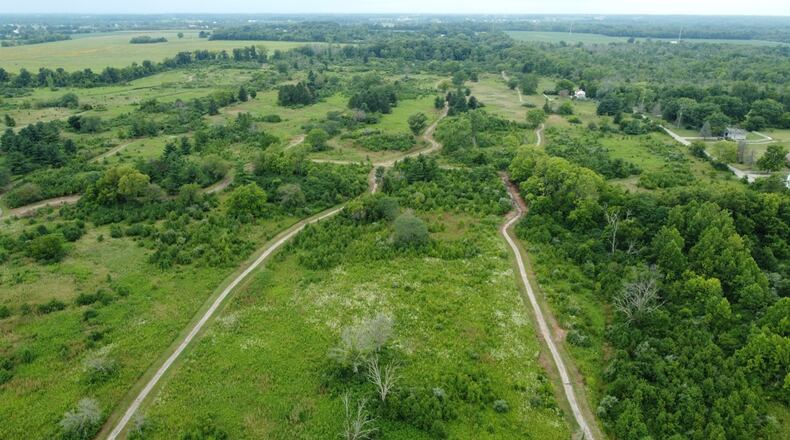The Spring Run Conservation Area is located in Trotwood on the site of the former Larch Tree Golf Course on North Snyder Road, south of Post Town Road.
“It is a former golf course gone wild,” said Grace Dietsch, regional conservation manager for Five Rivers MetroParks. “The site is a refuge for wildlife. Beavers, coyotes, fox, deer, groundhogs, and many species of birds—some quite rare—can be spotted regularly at Spring Run.”
Along with the installation of wetlands, the area is undergoing “significant restoration” to remove invasive plants, such as the Callery pear, Dietsch said.
The wetland project is part of the ODNR’s H2Ohio program, which was created by Gov. Mike DeWine in 2019 to combat algal blooms, and improve water quality and infrastructure. The ODNR said the wetland restoration project is fully funded by a $499,500 H2Ohio grant, which provides money for wetlands projects. Unlike some grants, the H2Ohio initiative grant does not require local matching funds.
By creating wetlands, the project hopes to improve water quality by reducing sediment and absorbing nutrients, expand wildlife habitat and prevent erosion from stormwater runoff as nearby Wolf Creek meets the Great Miami River near downtown Dayton.
According to Dietsch, before the land was used as a golf course, it was farmland. Prior to that, she said, the area was originally natural wetlands.
During its time as Larch Tree Golf Course, golf cart paths were installed throughout. These existing paths will be repaved for visitors to use, ultimately creating about a mile of trails.
“After the H2Ohio wetland restoration grant project is complete, we also hope to secure another grant to restore the former cart paths to be ADA-compliant paved trails,” Dietsch said. “People of varying skills and abilities could navigate this significant natural area to observe rare birds, connect with nature, and experience the beauty of wetlands.”
Future additions to the site may include improved fishing access, picnic areas, restrooms, and a maintenance facility, she added.
“We are excited to see the H2Ohio initiative expand beyond Lake Erie and into the Ohio River Basin,” DeWine said in a statement about the project. “These projects bring long-lasting solutions to water problems that can be found all over Ohio.”
Acting as the kidneys of our ecosystem, wetlands improve water quality and help with flood abatement while providing plant and wildlife habitat, according to Five Rivers. The new wetlands at Spring Run will store approximately 33 million gallons of water.
Along with improving water issues, the wetland restoration project will expand outdoor recreation opportunities for the residents of Trotwood and greater Dayton and create additional public access to a large natural area. The project will also prioritize the restoration of over 350 acres of grassland.
“A project like this is exactly what ODNR’s H2Ohio program strives for,” said ODNR Director Mary Mertz. “We are thrilled about the water quality benefits, as well as the positive impact on wildlife and inclusive recreational opportunities this new project will offer to those living in and others visiting southwest Ohio.”
Spring Run is situated within the Wolf Creek Watershed, part of the Great Miami Watershed — the largest in Ohio, which provides water to more than 2.3 million people.
Spring Run is currently open to the public, Dietsch said. Visitors can park in the lot along the road at 2765 N. Snyder Road and walk the paved trail system to access the area. There are also small fishing ponds just north of the parking lot where anglers can fish for bass and bluegill.
“If you’ve never been there, now is a great time to visit and see the restoration process in real time,” she said.
The wetland and grassland restoration is estimated to be completed by the end of 2023, Dietsch said, adding that the goal is to complete the subsequent trail improvements by 2025, though that timeline largely depends on grant eligibility, funding, and staff capacity.



